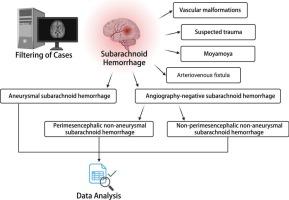脑实质周围非动脉瘤性蛛网膜下腔出血患者的临床特征及预后的单中心回顾性研究
IF 2.8
3区 医学
Q2 NEUROSCIENCES
引用次数: 0
摘要
脑周围非动脉瘤性蛛网膜下腔出血(pmSAH)是蛛网膜下腔出血(SAH)的一种亚型,其出血来源尚不清楚。与其他SAH类型相比,它通常与良性临床病程相关。本研究回顾性分析了2019年1月至2023年12月入院的198例蛛网膜下腔出血患者,以及137例非脑周非动脉瘤性蛛网膜下腔出血(npmSAH)和198例动脉瘤性蛛网膜下腔出血患者作为对照。结果显示,pmSAH的发生率约占所有SAH病例的5.6%,占非动脉瘤性SAH病例的59.1%。与aSAH和npmSAH患者相比,pmSAH患者表现出较轻的临床严重程度,具有较高的格拉斯哥昏迷评分和较低的Hunt-Hess评分。在发病时,pmSAH患者不太可能经历意识丧失、尿失禁或抽搐。他们的并发症也更少,住院时间更短,预后不良的比例也更低。多因素logistic回归发现并发症和Hunt-Hess分级是pmSAH预后不良的独立危险因素。总之,pmSAH患者的临床病程相对较轻,并发症较少,预后较好。然而,偶尔发生的情况需要进一步注意。本文章由计算机程序翻译,如有差异,请以英文原文为准。

A single-center retrospective study on clinical features and outcomes of perimesencephalic non-aneurysmal subarachnoid hemorrhage patients
Perimesencephalic non-aneurysmal subarachnoid hemorrhage (pmSAH) is a subtype of subarachnoid hemorrhage (SAH) where the bleeding source remains unclear. It is generally associated with a benign clinical course compared to other SAH types. This study retrospectively analyzed 198 pmSAH patients admitted between January 2019 and December 2023, along with 137 non-perimesencephalic non-aneurysmal subarachnoid hemorrhage (npmSAH) and 198 aneurysmal SAH patients as controls. Results showed that pmSAH incidence accounted for approximately 5.6% of all SAH cases and 59.1% of non-aneurysmal SAH cases. pmSAH patients exhibited milder clinical severity, with higher Glasgow Coma Scale scores and lower Hunt-Hess grades compared to aSAH and npmSAH patients. At onset, pmSAH patients were less likely to experience loss of consciousness, incontinence, or convulsions. They also had fewer complications, shorter hospital stays, and a lower proportion of poor prognosis. Multivariate logistic regression identified complications and Hunt-Hess grade as independent risk factors for poor prognosis in pmSAH. In conclusion, pmSAH patients demonstrated relatively mild clinical courses, fewer complications, and better prognosis. However, occasional occurrences require further attention.
求助全文
通过发布文献求助,成功后即可免费获取论文全文。
去求助
来源期刊

Neuroscience
医学-神经科学
CiteScore
6.20
自引率
0.00%
发文量
394
审稿时长
52 days
期刊介绍:
Neuroscience publishes papers describing the results of original research on any aspect of the scientific study of the nervous system. Any paper, however short, will be considered for publication provided that it reports significant, new and carefully confirmed findings with full experimental details.
 求助内容:
求助内容: 应助结果提醒方式:
应助结果提醒方式:


